

Therapsida. Therapsida is a group of synapsids, and includes mammals and their ancestors.[1][2] Many of the traits today seen as unique to mammals had their origin within early therapsids, including an erect posture.
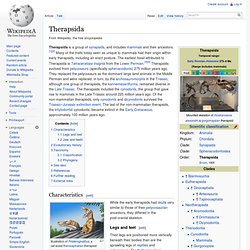
The earliest fossil attributed to Therapsida is Tetraceratops insignis from the Lower Permian.[3][4] Therapsids evolved from pelycosaurs (specifically sphenacodonts) 275 million years ago. They replaced the pelycosaurs as the dominant large land animals in the Middle Permian and were replaced, in turn, by the archosauromorphs in the Triassic, although one group of therapsids, the kannemeyeriiforms, remained diverse in the Late Triassic. The therapsids included the cynodonts, the group that gave rise to mammals in the Late Triassic around 225 million years ago.
Of the non-mammalian therapsids, only cynodonts and dicynodonts survived the Triassic–Jurassic extinction event. Characteristics[edit] Legs and feet[edit] Jaw and teeth[edit] Evolutionary history[edit] Archosaur. Archosaurs are a group of diapsid amniotes whose living representatives consist of birds and crocodilians.
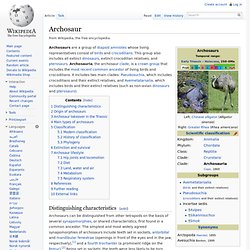
This group also includes all extinct dinosaurs, extinct crocodilian relatives, and pterosaurs. Archosauria, the archosaur clade, is a crown group that includes the most recent common ancestor of living birds and crocodilians. It includes two main clades: Pseudosuchia, which includes crocodilians and their extinct relatives, and Avemetatarsalia, which includes birds and their extinct relatives (such as non-avian dinosaurs and pterosaurs). Distinguishing characteristics[edit] Archosaurs can be distinguished from other tetrapods on the basis of several synapomorphies, or shared characteristics, first found in a common ancestor.
Dinosaur. Dinosaurs are a diverse group of animals of the clade Dinosauria. They first appeared during the Triassic period, 231.4 million years ago, and were the dominant terrestrial vertebrates for 135 million years, from the beginning of the Jurassic (about 201 million years ago) until the end of the Cretaceous (66 million years ago), when the Cretaceous–Paleogene extinction event led to the extinction of most dinosaur groups at the close of the Mesozoic Era. The fossil record indicates that birds evolved from theropod dinosaurs during the Jurassic Period and, consequently, they are considered a subgroup of dinosaurs by many paleontologists.[1] Some birds survived the extinction event that occurred 66 million years ago, and their descendants continue the dinosaur lineage to the present day.[2] Etymology Definition The common House Sparrow (Passer domesticus) is often used to represent modern birds in definitions of the group Dinosauria General description Distinguishing anatomical features.
Triassic.
Middle Triassic epoch. Late Triassic epoch. Laurasia. Origin[edit] Although Laurasia is known as a Mesozoic phenomenon, today it is believed that the same continents that formed the later Laurasia also existed as a coherent supercontinent after the breakup of Rodinia around 1 billion years ago.
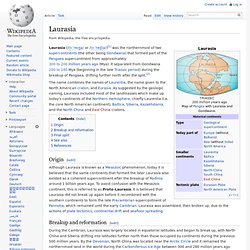
To avoid confusion with the Mesozoic continent, this is referred to as Proto-Laurasia. It is believed that Laurasia did not break up again before it recombined with the southern continents to form the late Precambrian supercontinent of Pannotia, which remained until the early Cambrian. Laurasia was assembled, then broken up, due to the actions of plate tectonics, continental drift and seafloor spreading. Breakup and reformation[edit] During the Cambrian, Laurasia was largely located in equatorial latitudes and began to break up, with North China and Siberia drifting into latitudes further north than those occupied by continents during the previous 500 million years.
Final split[edit] Around 200 million years ago, Pangaea started to break up. Gondwana. The adjective Gondwanan is in common use in biogeography when referring to patterns of distribution of living organisms, typically when the organisms are restricted to two or more of the now-discontinuous regions that were once part of Gondwana, including the Antarctic flora.
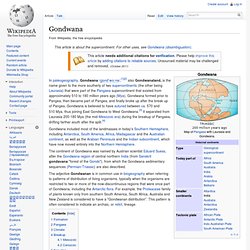
For example, the Proteaceae family of plants known only from southern South America, South Africa, Australia and New Zealand is considered to have a "Gondwanan distribution". This pattern is often considered to indicate an archaic, or relict, lineage. Formation[edit] The assembly of Gondwana was a protracted process. Permian–Triassic extinction event. Millions of years ago P–Tr Plot of extinction intensity (percentage of genera that are present in each interval of time but do not exist in the following interval) vs time in the past for marine genera.[1] Geological periods are annotated (by abbreviation and colour) above. The Permian–Triassic extinction event is the most significant event for marine genera, with just over 50% (according to this source) failing to survive. (source and image info) Triassic–Jurassic extinction event.
Millions of years ago Tr–J The blue graph shows the apparent percentage (not the absolute number) of marine animalgenera becoming extinct during any given time interval.
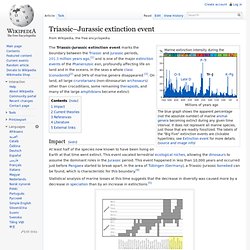
It does not represent all marine species, just those that are readily fossilized. The labels of the "Big Five" extinction events are clickable hyperlinks; see Extinction event for more details. (source and image info) Impact[edit] At least half of the species now known to have been living on Earth at that time went extinct. Statistical analysis of marine losses at this time suggests that the decrease in diversity was caused more by a decrease in speciation than by an increase in extinctions.[5]